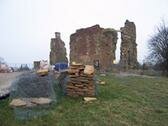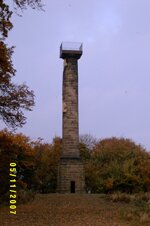Codnor Castle and the Jessop Monument
Region: East Midlands
Owner Type: Local Authority
Year of Intervention: May 2006 - May 2008
Summary: Codnor Castle, a Scheduled Monument, and the Jessop Monument, comprised of two Grade II listed buildings, all in the East Derbyshire coalfield, have been repaired and consolidated by a private coal-mining company, as a requirement of a planning permission for the extraction of coal by open-casting.
On a low ridge west of the Erewash valley in East Derbyshire stand the ruined walls of Codnor Castle. Built originally by Henry de Grey, after the Norman Conquest, it had been extended in various stages but finally abandoned as a dwelling in the 16th or early 17th century and left to decay ever since. Of the Castle, three precarious-looking walls of weathered local sandstone and brick still stand 8 metres high, amidst grazing land, below which extensive buried remains have been shown to exist. (A BBC TV “Time Team” exploration in 2007 charted extensive underground remains and unearthed a notable find, a gold noble of Henry V).
1 km to the North, in a slightly higher position stands the 27m high gritstone Tower and the Monument Hall, built on a hilltop as part of pleasure grounds for the local people, to commemorate the life of William Jessop the second, son of one of the founders of the Butterley Company who developed the extensive ironworks and village here at Ironville, just below Monument Hill and also at nearby Ripley.
The circular Tower was completed in 1854 with a viewing platform on top accessed by a narrow spiral staircase. Soon after, in 1861 it suffered a devastating lightning strike which jumped to earth via the iron bonding cramps in the stonework joints, bursting out whole blocks of stone on its way down. Nevertheless, as photographs confirm, the public continued to have access at least in the early 20th century and it remained standing upright.
Adjacent, just 10 years later, was built the Monument Hall, of local sandstone with delicate wrought iron trusses, made by the Butterley Company, carrying a slate roof. This barn-like structure was built to provide a large recreation space and was still in use for indoor tennis in the 1960s. Since then it had been abandoned and allowed to deteriorate although the walls and roof trusses survived intact. The informal Monument gardens had become overgrown and wild.
In the mid-1990s, the Castle, the Tower and the Hall were all buildings gravely at risk from neglect, decay and structural weaknesses. Having little or no prospects of new beneficial uses without extensive and non-profitable investment of funds, the structures faced a very uncertain future. The enclosing land had been bought by RJB Mining Ltd. The company proposed to extract 530,000 tones of coal in an area extending over most of the land between the Castle and Monument Hill.
There was a strong local campaign against the open-cast coal mining proposal and for the preservation of the structures and so negotiations ensued with a view to allowing the extraction while ensuring works to preserve the historically important structures.
In August 1998, Derbyshire County Council as minerals planning authority, granted RJB Mining Ltd, planning permission for open-cast extraction of coal, subject to the usual raft of conditions, including a requirement for the Company to enter into a legally binding agreement under Section 106 of the Town and Country Planning Act 1990. The Agreement required, inter alia, that
- Before the start of extraction, the Company is to submit to the Council detailed schedules of stabilisation and repair works to the Castle, the Tower, the Hall and the Grounds. In respect of the Castle, pre-extraction stabilisation works were required. The schedules had to be agreed with the Council and English Heritage and any necessary consents obtained.
- The stabilisation works to ensure no damage to the Castle were to be carried out before any excavation works were started within 300 metres of the castle moat.
- The Company was to ensure the implementation of the works by a reputable historic buildings architect.
- The works to the Castle were to be completed within 24 months of the cessation of coal extraction.
- The works to the Monument Tower, Hall and Grounds were to be completed within 12 months of cessation of coal extraction.
- The Company was to carry out all the agreed works at its own expense.
Following the Council’s decision to grant planning permission, negotiations got underway between the Council officers and RJB Mining’s chosen architect on the content and extent of the schedules of work.
In early 2001 RJB Mining sold the site with its planning permission to UK Coal Ltd. Coal extraction started in December 2001 and finished in May 2004. UK Coal Ltd knew its planning obligations when it acquired the site but upon completion of coaling, the Company had to be put under pressure to commence the works and carry them out in full.
However between May 2006 and May 2008 repair works to the Tower and Hall and consolidation works to Codnor Castle were carried out to a very high standard, by Croft Building and Conservation Ltd, a specialist firm based in the West Midlands, under the supervision of the architect Bob Tolley and the structural engineer Steve Mason of Hancock, Wheeldon and Ascough.
Planning obligations using a legally binding agreement under Section 106 of the 1990 Planning Act are not unusual in securing benefits for communities affected by environmentally disruptive developments. It was unusual however, at least in Derbyshire, for the future of historic structures to be secured by linking their repair to the grant of planning permission and putting all the costs on to the developer.
The three structures involved, even when repaired, have little prospect of ever returning an income to the developer and so the costs incurred are a net loss to the Company which must be set against the financial gains from the site. This was taken on board by RJB Mining when it obtained consent and subsequently by UK Coal when it bought the site.
Before any site excavation works started, UK Coal did, as required, employ a reputable architect (Bob Tolley of S T Walker and Duckham) and carried out the stabilisation works to the fragile Castle walls, with the approval of English Heritage officers. But following cessation of coaling in May 2004, UK Coal showed no urgency to meet the deadline obligations for carrying out the consolidation works to the Castle or the repair works to the Monument Tower and Hall. Despite pressure from the Council and attempts by the Company to reduce its financial liability while still meeting the obligations, it took until May 2006, for a meaningful start on site by UK Coal’s chosen contractor. Repair works on the Tower and Hall should have been completed by May 2005 and consolidation works on the Castle by May 2006.
At any time after May 2005, it was open to the Council to take UK Coal Mining Ltd to court for breach of covenants but it was felt that pursuing legal action while the buildings continued to deteriorate was not productive and that keeping up face-to-face pressure on Company personnel at as high a level as possible, would eventually produce the right results.
A planning obligation backed by a Section 106 Agreement, has been used effectively to achieve permanent repairs to historic structures which have little if any prospect of economically viable new uses, entirely at the expense of the beneficiary of the planning permission. All three structures have been removed from the English Heritage “Heritage at Risk” Register and the Derbyshire County Council’s Buildings-at-Risk Register.
Although currently privately owned, the structures can be considered as public assets, as the Tower, Hall and Grounds were originally intended to be. Following on from completion of the works, UK Coal Mining Ltd has been in discussion with two local voluntary groups, the Codnor Castle Preservation Society and the Jessop Monument Trust, with a view to possible local arrangements for future management and presentation to the public of the structures.
Little evidence of the former layout of the Monument grounds now exists and it has been agreed that the obligation to “repair” them will be met by twice yearly strimming of the grass and weeds by UK Coal, for the foreseeable future.
Keywords: LEGAL ACTION; REPAIR, RECONSTRUCTION, RESTORATION


